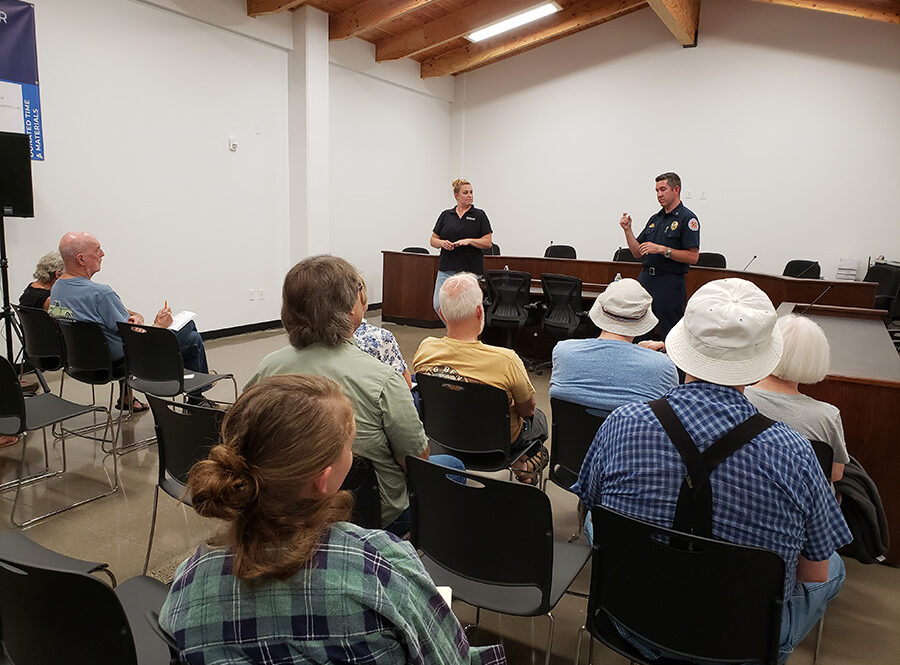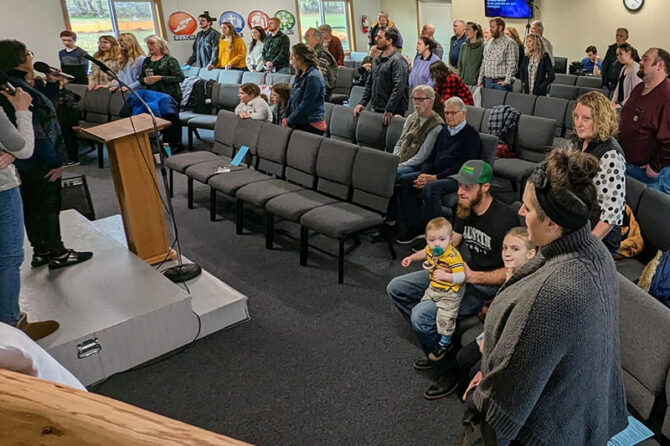Reporter for The Canyon Weekly
Detroit-area residents participated Tuesday in a briefing with state officials on new codes that are being developed on “defensible space.”
Defensible space refers to actions that reduce the amount of hazardous vegetation and combustible material around a building.
The code is mandated by Senate Bill 762, the new wildfire preparedness and resiliency bill signed in 2021 amid the fires that have plagued the state in the past few years, including the Labor Day 2020 blazes that affected huge swaths of the Santiam Canyon. SB 762 calls for property owners to take action on defensible space and fire-hardening if their properties are in the wildland urban interface and rated at either high or extreme fire risk based on state mapping.
The fire-hardening piece is being handled by the state Building Codes Division, while the risk maps are being reworked by the Oregon Department of Forestry and Oregon State University’s College of Forestry after a late June release was withdrawn amid withering criticism.
One of the challenges for the moderators from the Oregon Office of State Fire Marshal (OSFM) at Tuesday’s session was finding a way to limit questions and comments to defensible space issues. Folks in the audience at the Detroit Community Center also expressed concerns about the maps, possible insurance challenges and the absence of other agencies such as the U.S. Forest Service.
Chad Hawkins, assistant chief deputy for for life safety with the OSFM, who was participating in his 11th such town hall, noted that the maps were the hot topic elsewhere as well and had there been an all-agencies outreach format, defensible space never would have gotten its due.
“And it’s such an important part of resiliency, one that Detroit knows well, as well as other communities in the state,” Hawkins said. “And we want to hear from members of the community because you are the experts on your own property.”
Hawkins and co-moderator Alison Green, a public affairs officer with the OSFM, essentially went with a two-pronged attack – identifying both what defensible space is … and what it is not.
Defensible space means limiting fire sensitive vegetation within 100 feet of a home or commercial building.
“If you live, sleep, eat and work there then the code applies,” Hawkins said. “It’s not for garages, shops and outbuildings.”
Hawkins and Green recommended trimming up trees to at least 6 feet off the ground and Hawkins noted that Oregon State offers a fire-resistant plant manual
(available at https://catalog.extension.oregonstate.edu/pnw590).
The new code, which is set to be finished by Dec. 31 and to take effect April 2, 2023, will affect both current and future building.
Green said that there is a myth-busting component to the outreach effort.
“We want to educate people,” she said. “We’re not saying cut down every tree around the house.”
Hawkins, meanwhile, noted that widespread species such as Douglas fir and ponderosa pine are fire-resistant and if trimmed up can help enhance your defensible space.
Hawkins noted two key goals to the work, life safety and firefighting resources.
“If you have proper defensible space,” he said, “your home will slow down the fire, and it is likely that house will survive on its own and not need firefighters to go after it. The more people that have defensible space the better the community is protected.”
Several residents noted the challenge of rebuilding amid new costs and state requirements, but Green countered that “we’re not going to come out and visit your property and give you a ticket.”
“The OSFM doesn’t have fees,” Hawkins said. “Our goal is education and getting people to buy in. We want to talk about why that sprinkler or that sign will make things safer. If it is in the fire code that means something bad happened. And somebody might have died.”
One resident noted he might need help or special equipment to trim his trees as well as dispose of the debris.
Green noted that there is $25 million in grant funding available and that the use described by the resident is just what the grant money is intended to address. For information the grants email [email protected].
About a dozen residents attended the session, with Detroit Mayor Jim Trett, Laura Harris of the Idanha-Detroit Rural Fire Protection District and three Marion County Sheriff’s Office deputies also on hand.
Hawkins said that 600 people turned out at a session in Grants Pass, with the average for the 11 talks so far about 100 to 200. The Grants Pass meeting lasted more than 3 hours. A total of 17 meetings have been scheduled, but Hawkins said they might add two more.





